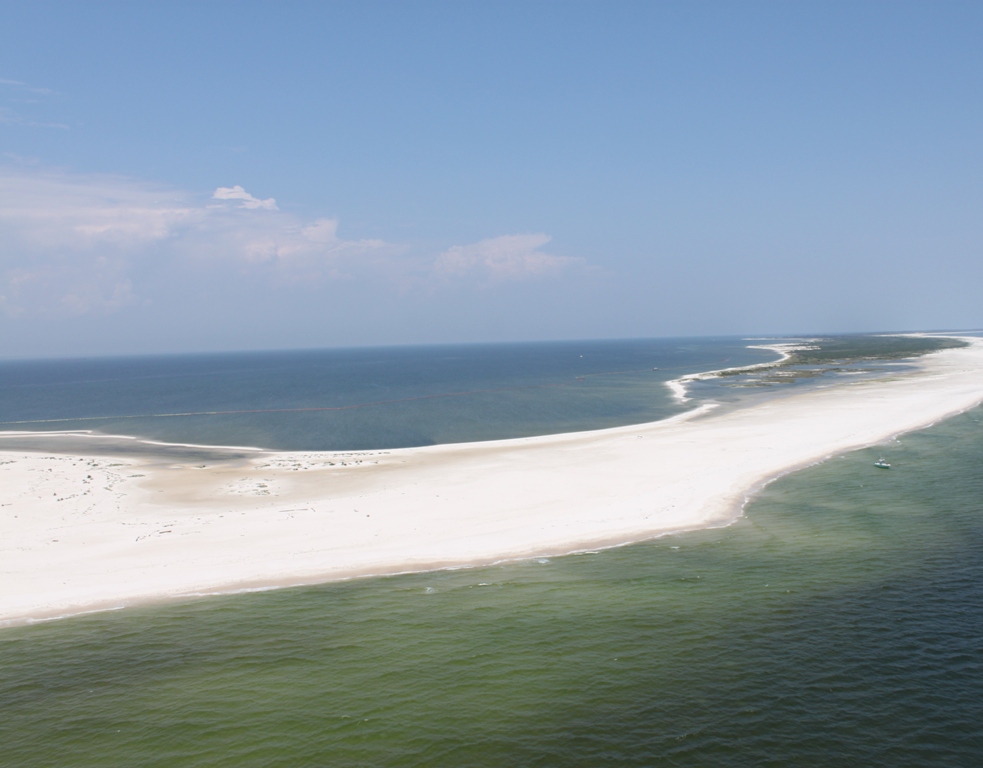from the National Park Service site:
NPS Oil Spill Response

NPS PHOTO
Overflight assessing boom conditions, Gulf Islands NS
Background
On April 20, 2010 an oil rig exploded in the Gulf of Mexico. 126 people were on board and 11 people are still missing and presumed dead. Currently, oil is leaking from the well into the Gulf.
What we're doing
As of May 25, 2010, the National Park Service has two incident management teams deployed to respond to potential oil impacts in the Gulf. Additionally, National Park Service employees are supporting the response both at the scene of the oil spill and from across the country as subject matter experts and by providing technical information.
The National Park Service is focused on human safety and resource protection in eight national parks in the Gulf area (see below). These parks are working to assess resources, collect baseline data, coordinate boom placements, plan for responsible cleanup, install barriers for shore bird and turtle nest protection (during cleanup), and plan for potential park closures, if necessary.
For more information from the U.S. Public Health Service on the potential health effects of oil exposure, pleaseclick here.
Who we work with
After oil spills, the responsible party (in this case BP) is legally required to fund and organize the cleanup under the U.S. Coast Guard. So even though you may not see rangers out on the beaches cleaning up oil, we’ll be there making sure that our natural and cultural resources are not damaged any further.
Park status
For information about park closures and specific park operations, go to:
Gulf Islands National Seashore, FL and MS
Resources at risk
National parks in the Gulf area are home to many amazing animals, habitats, and cultural resources. Here are just a few that could be affected by the oil spill:
- Seagrass beds are important nursery habitat for sea turtles, young fish, crabs, shrimp, and many other crustaceans. They also provide an important food source for manatees. Oil will kill seagrasses on contact and this community is slow to recover.
- Salt marshes, which occur in back bays, provide a buffer that protects the mainland during storm events. They also offer foraging sites for all kinds of birds. If oil kills these plants in the marsh, the soil will destabilize and erode.
- Mangroves are similar to salt marshes in that they provide a buffer between the sea and the mainland, as well as providing wildlife habitat.
- Shipwrecks, archeological sites, Civil War defenses, historic structures, and other cultural resources tell the stories of past inhabitants and key moments in our nation’s past. Damage from oil and cleanup operations is a concern for these treasures.
Learning the hard way
We wish it weren't true, but the National Park Service has a lot of experience with oil spill cleanup. In 1989, the Exxon Valdez ran aground in Alaska spilling 257,000 barrels of oil that washed up on the shores of three national parks. What was learned from that experience two decades ago is having a profound effect on what we are doing today in the Gulf. For more -- Kenai Fjords National Park wrote a summary, called 20 Years Later, detailing their experience with the Exxon Valdez oil spill.
How you can help
- Report oiled/distressed wildlife: (866) 557-1401
- Report community impacts: (866) 448-5816
- Volunteer: (866) 448-5816
- Register as a consultant, contractor, or vendor: (281) 366-5511
- Register boats available to assist: (281) 366-5511
Learn more
- About the entire incident (Unified Command)
- About Department of the Interior response
Media inquiries
- About Gulf Islands (850) 916-5638
- About South Florida parks (305) 224-4215
- About Unified Command (985) 902-5240

No comments:
Post a Comment